E-Archive
Interview
in Vol. 19 - January Issue - Year 2018
Blasting and Degreasing in one step - Automatic and Process Reliable
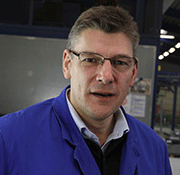
Thorsten Evert, Managing Director of PantaTec
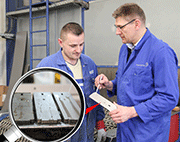
Wetting test with water: 1. Untreated and greasy; 2. Blasted and still greasy; 3. Blasted and grease free
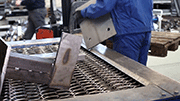
Oily parts
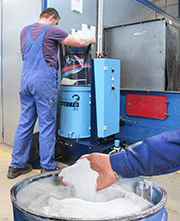
Prep with additive
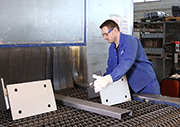
Clean surface
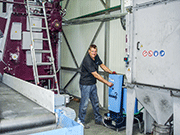
Installation and commissioning of an automatic dosing system INJECTO 05
MFN was able to get an interview with Thorsten Evert, Managing Director of PantaTec.
Blasting with metallic blasting media is used as a standard procedure in the surface treatment of metals, e. g. surface preparation for corrosion protective coatings, preparation before metal forming, finish blasting after pressure die casting, after metal forming or heat treatment, and shot peening.
However, there is an important aspect that requires particular attention that can adversely interfere with and affect the blasting process and its results from the outset:
Contamination of blasting process and parts' surface by oily and greasy residues from manufacturing.
(?) MFN: Mr. Evert, your company developed a procedure to counteract this problem. Please tell us more.
(!) T. E.: In order to eliminate contamination of blasting process and parts' surface PantaTec designed an alternative technology, which combines Blasting and Degreasing in just one step.
Finally, it is a booster to the existing blasting process for the treatment of metal surfaces.
The cleaning additive ULTIMATE just needs to be mixed into the blasting media.
Then, it can remove oil and grease from the metal surfaces of the blasted parts, the blasting media and the blasting system.
(?) MFN: And how exactly does the PantaTec system work?
(!) T. E.: This technique uses an additive consisting of mineral substances in powder form. This exerts very strong adhesive forces on oils, greases, lubricants, coolants and release agents, etc.
The additive is continuously mixed into the circulating blasting medium and is immediately effective.
The additive particles are in the form of platelets, somewhat like cornflakes, but much smaller. As a result, a large surface is covered with particles very quickly when blasting. The transfer of oils and greases from the metal to the additive takes place in fractions of a second. The particles are then loosened by blasting. Their special grain shape subsequently aids transport through the existing air flow in the blasting machine. The additive particles, with the attached oils and greases, are then separated out from the process through the conventional dust extraction, air wash separator and filtration system. The impurities are therefore transferred to the filter dust and can be disposed of with the dust easily.
(?) MFN: How can the user determine the level of cleaning?
(!) T. E.: Depending on requirements, the degree of cleanliness achieved can be defined and set for stable and repeatable operation. The key parameters are the concentration of the additive in the mixture and the coverage of blasting on the parts' surfaces.
(?) MFN: That sounds like a simple but effective method!
(!) T. E.: Yes, and through integration of degreasing in the blasting process, a complete separate operation can be skipped. At the very least, therefore, pre-cleaning before blasting can be omitted, without the carryover of oils or greases negatively influencing the blasting process or following manufacturing steps.
Process reliable achievement of the desired blasting results.
As a result of the technical benefits and improved process reliability, there are of course further economic impacts: Which means that using the PantaTec process opens up considerable potential for cost savings. This must be always considered in individual detail.
(?) MFN: How does the implementation of the PantaTec process work in detail?
(!) T. E.: Normally, the PantaTec Process is carried out with an automatic dosing system. This provides the required process reliability and, as a consequence, the level of quality assurance. Of course some new users do it manually in the beginning for test purposes. That is ok.
But in the past the majority of users of the PantaTec process have been pushing for a simple but reliable and cost-effective solution. In 2013, PantaTec put forward a first proposal for an effective and efficient process with the injection principle. This process has already more than proven itself.
Lately PantaTec has introduced the 2nd generation of the INJECTO 05 automatic dosing system. The new design includes not only an adequate storage container and defined PLC controlled dosing, but also delivery of the additive, from the production hall floor to the blasting media hopper, over a height of up to 10 m with line length up to 50 m.
Equally, the increased effectiveness and efficiency of the process is improved even further, as the additive feed can be introduced at the optimum position for process engineering.
Using appropriate process control with water or more specifically, with test ink, determination of the operating point can then take place. This is defined and held permanently stable and repeatable by the PLC controlled dosing unit.
Process reliability is maintained.
(?) MFN: Is the installation of such a dosing system very complicated?
(!) T. E.: No, not at all! The INJECTO 05 plug-and-play system can be integrated with little effort in both new installations as well as a retrofit in existing blasting systems. The effort involved in installation is about the same as connecting a new washing machine at home.
The INJECTO unit is linked with the shot blasting system so that the cleaning additive is introduced only during the active blasting period. This means that the function of the additive is always assured when it is needed. Conversely, this link to the blasting process also saves unnecessary consumption of additive.
(?) MFN: So please tell us more about the operation of the dosing unit.
(!) T. E.: It's dead easy. The dosage quantity, according to the desired level of cleanliness of the blasting system, is shown on the display of the PLC control system in plain text (in litres/blasting hour). The adjustment of the dosage is simply performed with two push buttons, one for more and one for less additive.
The system monitors the correct functioning of the dosing unit and gives an alarm signal when the minimum fill level (with reserve) is reached, for the operator to refill the machine. The operator then fills the machine with a complete 50-litre bag, and then resets the alarm and continues operation.
As a result of the automated process, the defined, stable and repeatable level of cleaning required for the blasted metal surfaces is achieved.
(?) MFN: What feedback do you receive from your customers?
(!) T. E.: The existing and prospective users of the PantaTec process have sent us a clear message:
PantaTec works excellently, but the process must definitely be automated for reasons of process reliability. Naturally, the solution needed to be reliable, easy to use and cost-efficient. In addition, a simple way for installation was required, that was capable of retrofitting and, of course, independent of the manufacturer and design of the shot blasting system.
We believe that we have managed it quite well, with a price for the basic version even under € 7,000. The current demand for the INJECTO 05 has proven itself, and it is a major boost to the PantaTec process as a whole.
MFN would like to thank Thorsten Evert for this interview!
For Information:
PantaTec GmbH
Carl Zeiss Str. 8
32549 Bad Oeynhausen, Germany
Tel. +49.5734.51488-50
E-mail: info@pantatec.de
www.pantatec.com



























